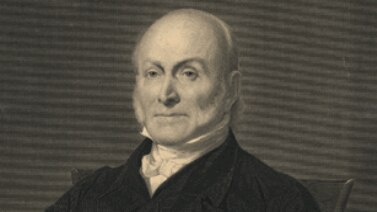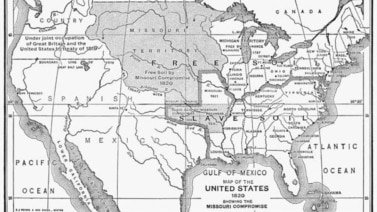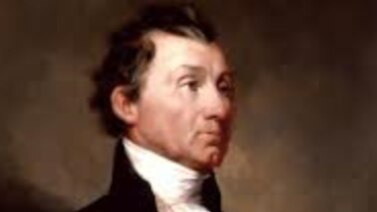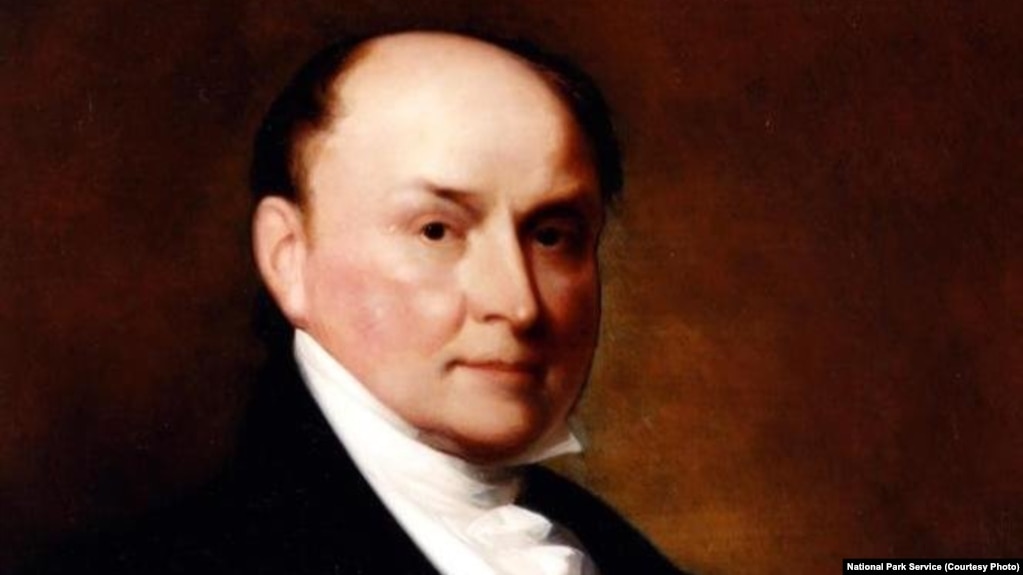
From VOA Learning English, welcome to The Making of a Nation, our weekly program of American history for people learning English. I’m Steve Ember.
John Quincy Adams was sworn in as president of the United States on March 4, 1825. A big crowd came to the Capitol building for the ceremony. All the leaders of government were there: senators, congressmen, Supreme Court justices and James Monroe. Monroe’s two terms as president were ending.
President-elect Adams focused his inaugural address on unity. Adams said the Constitution and the representative democracy of the United States had proved a success. The nation was free and strong and stretched across the continent, from the Atlantic Ocean to the Pacific.
He noted that during the past 10 years, political party differences had eased. So now, he said, it was time for the people to settle their differences and make a truly national government.
Adams closed his speech by recognizing that he was a minority president. No candidate had received a majority of electoral votes. So the House of Representatives had to make the decision. The House chose Adams as the next president. He told the crowd gathered at the Capitol that he needed the help of everyone in the years to come.
Presidents-elect used to give their inaugural address before their swearing in. So, after his speech, John Quincy Adams took the oath of office that made him the sixth president of the United States.
His father was John Adams, the second president. John Quincy’s mother, Abigail, made sure he received an excellent education.
Historian Harlow Giles Unger wrote a biography of John Quincy Adams – “Quinzy” incidentally is how the family pronounced it. The historian tells this story about Abigail Adams and her son in 1775 in Massachusetts during the Revolutionary War.
“When her first-born son John, John Quincy, was seven, they heard the cannon fire in the distance and they went up to the top of the hill behind their farm house and could look across Boston Harbor and see the Battle of Bunker Hill. And she took her boy by the hand and they went back down to the house and she started melting down the family pewter, with John Quincy helping her, and making musket balls for the American revolutionary troops.”
Abigail and John Adams were strong patriots. They were one of the founding families of America. Harlow Giles Unger says Abigail Adams raised John Quincy to serve his country.
“She told her son that if you do not grow up to be a great leader of this country, it will be because of your own laziness and obstinacy. She and her husband, John Adams, at that point decided to raise their son to be the president of the United States.”
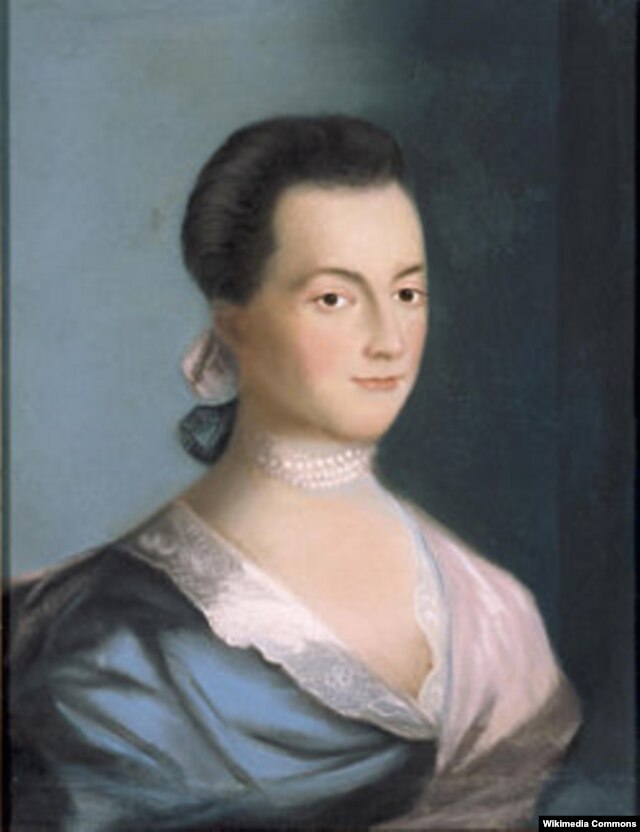
As a boy, John Quincy Adams learned to speak at least four languages and read Greek and Latin. He studied Shakespeare’s plays. He traveled in Europe. He worked with his father in American consulates and embassies.
He graduated from Harvard and was working as a lawyer by the age of 23.
“He was a brilliant, brilliant young boy and man.”
For about 25 years, Adams held mostly appointed jobs. He was ambassador to the Netherlands, Germany, Russia and Britain. He helped lead the negotiations that ended the War of 1812 between Britain and the United States. And he served eight years as secretary of state.
Adams spent most of his career working in public service. Harlow Giles Unger says he could be impatient, especially with lawmakers.
“He despised most of the politicians he met in Congress because he found them to be ignorant and self-serving, with no sense of patriotism and sense of obligation to the nation.”
John Quincy Adams did not care for political battles. When he became president, he tried to bring his political opponents and the different parts of the country together in his cabinet. His opponents, however, refused to serve. And, although his cabinet included southerners, he did not really have the support of the South.
(MUSIC)
In his first message to Congress, President Adams described his ideas about the national government. The chief purpose of the government, he said, was to improve the lives of the people it governed. To do this, he offered a national program of building roads and canals. He also proposed a national university and a national scientific center.
Adams said Congress should not be limited only to making laws to improve the nation's economic life. He said it should make laws to improve the arts and sciences, too.
Many people of the West and South did not believe that the Constitution gave the federal government the power to do all these things. They believed that these powers belonged to the states. Their representatives in Congress rejected Adams’ proposals.
Harlow Giles Unger says some of the disagreements during Adams’ presidency helped start the American Civil War more than 30 years later, in 1861.
“The country was now splitting. The South, most of the South, had never accepted the Constitution as such. The Constitution did away with state sovereignty, but many Americans never accepted that, and especially in the South.”
The political picture in the United States began to change during the administration of John Quincy Adams. His opponents won control of both houses of Congress in the elections of 1826.
Adams’ opponents called themselves Democrats. They supported Andrew Jackson and wanted him to win the next presidential election.
Democrats needed the support of both the West and the South to elect Jackson. So they proposed a bill that appeared to help the West.
The bill involved import taxes. A number of western states wanted duties on industrial goods imported from other countries. The purpose was to protect their own industries.
Southern states, however, opposed the import duties. They produced no industrial goods that needed protection. They argued that the Constitution did not give the government in Washington the right to approve such taxes.
(MUSIC)
The Democrats expected Congress to defeat the bill they proposed. They thought the West would be grateful that the Democrats had tried to help them. And the South would be happy that there would be no import taxes.
But to the Democrats' surprise, many congressmen from the Northeast joined with lawmakers from the West to support the bill. They did so even though the bill would harm industries in the Northeast. The Northerners wanted to keep the idea of protective trade taxes alive.
The bill passed in both the House of Representatives and the Senate. This left President Adams with a difficult decision. Should he sign it into law? Or should he veto it?
If he signed the bill, it would show he believed that the Constitution allowed protective duties. That decision would create even more opposition to him in the South. If he vetoed it, then he would lose support in the West and Northeast. Adams signed the bill. But he made clear that Congress was fully responsible for it.
Democrats in Congress made other attempts to weaken support for Adams. For example, they claimed that he was misusing government money. They tried to show that he, and his father before him, had become rich from government service.
Others accused him of giving government jobs to his supporters. This charge was false. Top administration officials had urged Adams to give government jobs only to men who were loyal to him. But Adams had refused. He felt that as long as someone had done nothing wrong, he should continue in his job.
During his four years as president, Adams removed 12 people from government jobs. In each case, the person had failed to do his work or had done something criminal.
Adams often gave jobs to people who did not support him politically. He believed it was wrong to give a person a job just for political reasons. Many of Adams' supporters could not understand. They had worked hard to get him elected. Their support for him cooled.
Historian Harlow Giles Unger says John Quincy Adams was never able to meet the high expectations many had for him.
“His presidency was a complete failure. He was able to accomplish nothing.”
The political battle between Adams' Republican Party and Jackson's Democrats remained bitter. Perhaps the worst fighting took place in the press. Each side had its own newspaper for support. The Daily National Journal supported the administration. The United States Telegraph supported Andrew Jackson.
At first, the pro-administration newspaper called for national unity and an end to personal attacks. Then things changed. The paper had to defend against charges of political wrongdoing within Adams’ party. It needed to turn readers away from these problems. So it printed a pamphlet that had been used against Andrew Jackson during an election campaign.
The pamphlet accused Jackson of many bad things. The most damaging part involved the wife of another man. That will be our story next week.
(MUSIC)
I’m Steve Ember, inviting you to join us next time for The Making of a Nation — American history from VOA Learning English.
